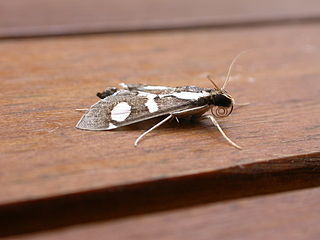
Glyphodes is a genus of moths of the family Crambidae described by Achille Guenée in 1854.

Diaphania indica, the cucumber moth or cotton caterpillar, is a widespread but mainly Old World moth species. It belongs to the grass moth family, and therein to the large subfamily Spilomelinae. This moth occurs in many tropical and subtropical regions outside the Americas, though it is native to southern Asia; it is occasionally a significant pest of cucurbits and some other plants.

Glyphodes bivitralis is a moth of the family Crambidae described by Achille Guenée in 1854. It is native to south-east Asia, including Hong Kong, India, Japan, Taiwan and Thailand. It is also found in Queensland, Hawaii and Maldives.
Glyphodes perelegans is a moth of the family Crambidae described by George Hampson in 1898. It is native to South America, where it is found in the Andes Mountains of Venezuela, Colombia, and Ecuador. It has been introduced to Hawaii to control banana poka.

Glyphodes negatalis, the karanj defoliator, is a moth of the family Crambidae. The species was first described by Francis Walker in 1859. It has a wide range in the tropics, including South Africa, The Gambia, Mali, India, Sri Lanka, Hong Kong, Japan, and eastern Australia.

Glyphodes microta is a moth of the family Crambidae. It is found in Australia, where it ranges from the east coast to the west coast across the middle of the continent.

Glyphodes sibillalis, the mulberry leaftier moth, is a moth of the family Crambidae. It is found in the southern United States, Central and South America and the West Indies.

Glyphodes bicolor is a species of moth of the family Crambidae described by William John Swainson in 1821. It is widely distributed in the Old World tropics, including South Africa, China, Thailand, India, New Guinea and Australia.

Glyphodes boseae is a moth of the family Crambidae. It was described by Max Saalmüller in 1880 and it is found in Madagascar.
Glyphodes bitriangulalis is a moth of the family Crambidae described by Max Gaede in 1917. It is found in South Africa (Gauteng), Zimbabwe, and Mali.

Glyphodes multilinealis, the fig-tiger-moth, is a species of moth of the family Crambidae described by George Hamilton Kenrick in 1907. It is found in Papua New Guinea, Fiji, Niue, the Cook Islands, the Society Islands, in Australia and Japan.

Glyphodes perspicualis is a species of moth of the family Crambidae. It was described by George Hamilton Kenrick in 1907 and it is found in Papua New Guinea.

Glyphodes paucilinealis is a species of moth of the family Crambidae. It was described by George Hamilton Kenrick in 1907 and is found in Papua New Guinea.
Glyphodes doleschalii is a moth of the family Crambidae described by Julius Lederer in 1863. It is found in Queensland in northern Australia.

Glyphodes cyanomichla is a moth of the family Crambidae described by Frederic Moore in 1888. It is found in the Bengal region and in Taiwan.

Glyphodes pulverulentalis is a moth of the family Crambidae. It was first described by George Hampson in 1896.

Glyphodes pyloalis, the lesser mulberry snout moth, lesser mulberry pyralid or beautiful glyphodes moth, is a moth in the family Crambidae. It was described by Francis Walker in 1859. It is found in Iran, China, Japan, India, Indonesia (Sumatra), Sri Lanka, Taiwan, the Democratic Republic of the Congo, Equatorial Guinea, Mozambique and North America, where it has been recorded from Florida, Maryland, North Carolina, South Carolina and Virginia.

Glyphodes stolalis is a moth in the family Crambidae. It was described by Achille Guenée in 1854. It is found in Cameroon, the Comoros, the Democratic Republic of the Congo, Kenya, Réunion, Madagascar, the Seychelles, South Africa (KwaZulu-Natal), the Gambia, Uganda, Zimbabwe, China, India, Indonesia (Sulawesi), Sri Lanka, Japan, Taiwan, Thailand and Australia.












